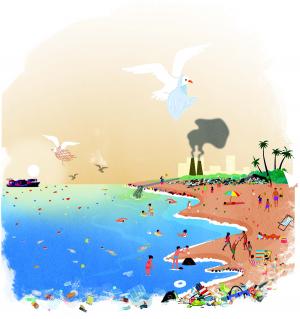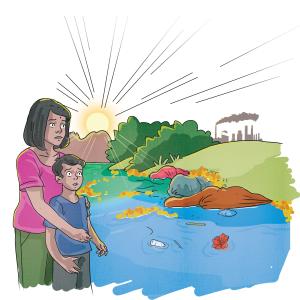
Explore how plastic, oil, chemicals, and even noise are choking marine life—and what we can do to help.

Meet the students turning kayaking into a weekly mission to collect plastic waste and keep the backwaters clean — one paddle at a time.

As millions gather for Maha Kumbh 2025, can we ensure our rivers remain clean? Aarav’s journey reveals the urgent need to protect our sacred waters from pollution and neglect.

Dive into River Tales, Festivals, and a DIY Splash—just bring water, petals, and mud!

Performing tangible actions to achieve credible solutions—making eco-friendly cleaning agents and raising awareness on chemically-intense products to control pollution. ******************************************************************************** The unsettling sight of the Bellandur Lake—a foamy, cloudy demon gargling bubbles—and plastic litter—baffling mounds disposed irresponsibly—motivated me to act and revive our wonderful world. We all know that the climate crisis is going off the charts and the practise of ‘Reduce, Reuse, and Recycle’ is gaining alarming urgency. Thus, it&…

A refreshingly sweet and innocent observation by a child of an otherwise very worrying issue of—river pollution—with a heartwarming appeal for water conservation. Once upon a time, during the holidays, I was travelling from Delhi to my village nearby. On the way, we guys came across the Yamuna River. Looking at the river, my younger brother instantly commented, “It doesn’t snow in Delhi even during winters. But here, on the river, it seems to have snowed in peak summers!”... Then, I explained to him that the white foam on the river surface is not snow but the chemical effluents emitted by huge …

What are Micro-Plastics? Micro-plastics have not been defined in particular. They are just tiny particles that result from the disintegration of bigger plastic materials. However, most researchers say that any plastic smaller than 5 millimetres in size is a micro-plastic. Hence, these are really, really teeny-tiny! Plastics are made up of polymers, which are derived from fossil fuels. A whole lot of chemicals are added to the polymers—close to 10,000—to ensure that a given plastic has the desired properties...

Water is colourless. But when we observe any large water body, it appears blue. When it has a lot of impurities (or nutrients), it can vary from red, green, white, grey, brown, black to anything that is weird and filthy. Read about some important terms related to different colours of water that we come across in common parlance or which researchers use to understand better this elixir of life. Bluewater: ‘Why is water blue in colour?’—humans must have raised this question since time immemorial. But in 1921, this query was resolved when Sir CV Raman raised and answered it successfully...

The Yamuna River is the largest tributary of the Ganga. It travels barely a distance of 22 km through Delhi. However, this region contributes to about 80 per cent of its total pollution load. Currently, this stretch discharges waste water from almost 22 drains into the river. Untreated effluents, containing toxins and chemicals, released from houses and industries creates froth (white foam) on the river’s surface. Algae, in addition, prevents sunlight from venturing into the depths of this river. Plus, low water level in the river causes concentration of these pollutants…

